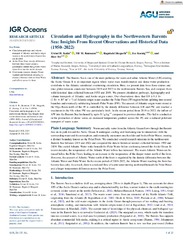Circulation and Hydrography in the Northwestern Barents Sea: Insights From Recent Observations and Historical Data (1950–2022)
Permanent link
https://hdl.handle.net/10037/36451View/
Published version (PDF)
Date
2024-08-13Type
Journal articleTidsskriftartikkel
Peer reviewed
Author
Kolås, Eivind Hugaas; Baumann, Till Martin; Skogseth, Ragnheid; Koenig, Zoe Charlotte; Fer, IlkerAbstract
The Barents Sea is one of the main pathways for warm and saline Atlantic Water (AW) entering the Arctic Ocean. It is an important region where water mass transformation and dense-water production contribute to the Atlantic meridional overturning circulation. Here, we present data from three cruises and nine glider missions conducted between 2019 and 2022 in the northwestern Barents Sea, and compare them with historical data collected between 1950 and 2009. We present circulation pathways, hydrography and volume transports of Atlantic- and Arctic-origin waters. Our observations show that 0.9 ± 0.1 Sv (1 Sv = 106 m3 s−1) of Atlantic-origin water reaches the Polar Front (PF) region before splitting into several branches and eventually subducting beneath Polar Water (PW). The amount of Atlantic-origin water stored in the Olga Basin north of the PF is controlled by the density difference between AW and PW, and reached a maximum in the 90s when PW was particularly fresh. In the recent period from 2019 to 2022, the inflow of AW into the Barents Sea freshened by up to 0.1 g kg−1 compared to previous decades. This led to a reduction in the production of dense water, an increased temperature gradient across the PF, and a reduced poleward transport of warm water. The Barents Sea is one of the main pathways for warm and saline Atlantic Water (AW) entering the Arctic Ocean. It is an important region where water mass transformation and dense-water production contribute to the Atlantic meridional overturning circulation. Here, we present data from three cruises and nine glider missions conducted between 2019 and 2022 in the northwestern Barents Sea, and compare them with historical data collected between 1950 and 2009. We present circulation pathways, hydrography and volume transports of Atlantic- and Arctic-origin waters. Our observations show that 0.9 ± 0.1 Sv (1 Sv = 106 m3 s−1) of Atlantic-origin water reaches the Polar Front (PF) region before splitting into several branches and eventually subducting beneath Polar Water (PW). The amount of Atlantic-origin water stored in the Olga Basin north of the PF is controlled by the density difference between AW and PW, and reached a maximum in the 90s when PW was particularly fresh. In the recent period from 2019 to 2022, the inflow of AW into the Barents Sea freshened by up to 0.1 g kg−1 compared to previous decades. This led to a reduction in the production of dense water, an increased temperature gradient across the PF, and a reduced poleward transport of warm water.
Publisher
WileyCitation
Kolås, Baumann, Skogseth, Koenig, Fer. Circulation and Hydrography in the Northwestern Barents Sea: Insights From Recent Observations and Historical Data (1950–2022). Journal of Geophysical Research (JGR): Oceans. 2024;129(8)Metadata
Show full item recordCollections
Copyright 2024 The Author(s)


 English
English norsk
norsk
